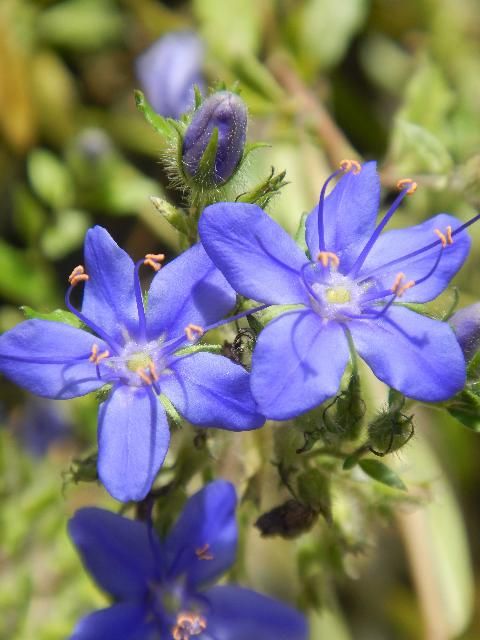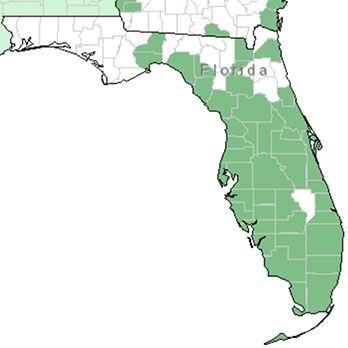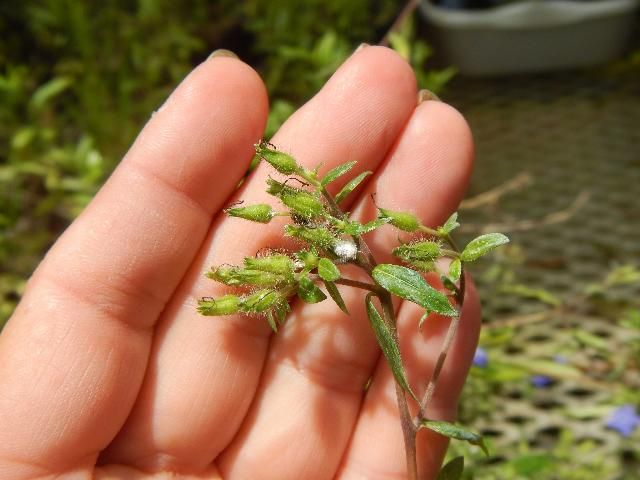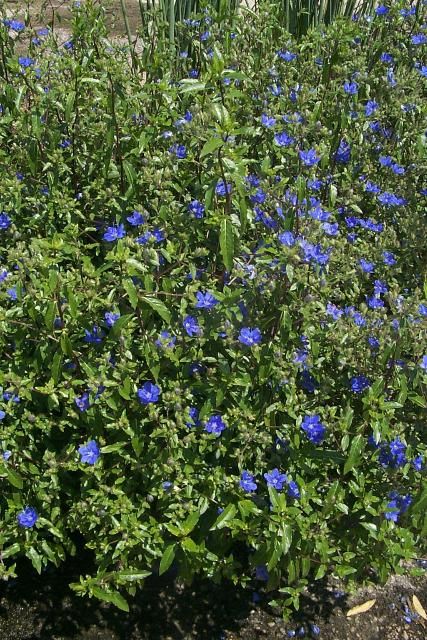Introduction
Skyflower is a herbaceous perennial wetland plant that grows in marshes, wetlands, and ditches and around the margins of lakes and ponds. Skyflower is a species native to Florida and is recommended for Florida aquatic gardens. It can reach up to 3’ in height and multi-stemmed specimens can have a spread of 1’ or more. The leaves of skyflower are lanceolate (sword-shaped) and can be up to 2.5” long and 0.5” wide. The leaf margins are serrate (having small, sharp teeth that point toward the tip of the leaf). The leaves are sessile (lacking a petiole or leaf stalk) and are attached directly to the stem in an alternate arrangement. The most striking characteristic of skyflower is its brilliant blue flowers, which are around 1” wide and often borne in corymbs (clusters). Orange pollen is produced by skyflower, resulting in a vibrant, "Go Gators!" color palette.

Credit: Lyn Gettys, UF/IFAS
Classification
Common Name
Skyflower
Scientific Name
Hydrolea corymbosa J. Macbr. ex Elliott
Family
Hydrophyllaceae (waterleaf family)
Distribution and Habitat
Skyflower is broadly distributed throughout Florida and can be found in most of the state's 67 counties, although the plant often goes unnoticed unless it is flowering. The species is less common in other coastal southeastern states, but native populations have been reported in Alabama and a handful of counties in Georgia and South Carolina (US Department of Agriculture, Natural Resources and Conservation Service (USDA NRCS) 2024a). Skyflower is classified as an obligate wetland species, meaning that it almost always occurs in wetland opposed to terrestrial environments, though it grows well with “wet feet” (damp soil) and can be used as a garden ornamental, provided soil is kept moist.

Credit: USDA NRCS
Propagation
Skyflower dies back to the ground when the weather turns cool in most areas; overwintering rhizomes produce new shoots in early spring, and flowering occurs from late spring through early fall. Unopened flower buds are protected by sepals (green, leaf-like structures) that are lanceolate and appear fuzzy because they are densely covered with fine hairs. Flowers are a clear, brilliant blue and are borne in cymes or leafy panicles (clusters). The species is hermaphroditic, meaning flowers have both male and female reproductive structures. Seeds are produced after pollination with the bright-orange to gold pollen, which is usually transferred by bees. Unripe seed capsules are green and covered with dense hairs and turn dark brown as they ripen. Each ripe capsule contains copious amounts of small seeds that germinate readily without special treatment. Skyflower can also be propagated by cuttings, by division, or by removing and potting up the numerous suckers produced by the species.

Credit: Lyn Gettys, UF/IFAS
Other Species of Hydrolea
In addition to Hydrolea corymbosa, there are four more species of Hydrolea in the United States; all are native to the US, and three (all except H. spinosa—spiny false fiddleleaf) occur in Florida. The only reported Florida population of H. ovata, known commonly as blue waterleaf, hairy hydrolea, false fiddleleaf, and ovate false fiddleleaf, was found in Okaloosa County in the extreme northern panhandle. The species is much more common in Texas, Louisiana, and Arkansas, and populations are also found in a handful of counties in Missouri, Kentucky, Tennessee, Mississippi, and Georgia (USDA NRCS 2024b). The species is used for wetland restoration in Texas (Davis undated). Blue waterleaf is similar in appearance to skyflower, but there are several notable differences. Leaves of blue waterleaf have smooth margins and petioles, 0.5”-long spines are present at each leaf node, and pollen is white. In contrast, skyflower has sessile leaves with serrate margins, no spines, and orange pollen (Godfrey and Wooten 1981). Waterpod (H. quadrivalvis) occurs mostly in north-central and northwest Florida (USDA NRCS 2024c). The flowers of waterpod produce white pollen and are borne in the leaf axils, which may also host short, stiff spines. Leaves have petioles and smooth to wavy margins and are broader than those of skyflower (Godfrey and Wooten 1981). Only three Florida counties—Sarasota, Miami-Dade, and Monroe—have reported populations of oneflower false fiddleleaf (Hydrolea uniflora) (USDA NRCS 2024d). This species is present in Texas, Louisiana, Mississippi, Alabama, Arkansas, Tennessee, and Missouri; it is listed as endangered in Illinois and of special concern in Kentucky (USDA NRCS 2024d). Oneflower false fiddleleaf is similar in appearance to waterpod, but flowers are produced individually instead of in clusters (Godfrey and Wooten 1981).
Uses
As indicated earlier, skyflower grows well in moist soil and has the potential to be an excellent addition to moist areas of the garden or landscape. However, few nurseries have skyflower available for purchase, so finding plants to add to the landscape can be a challenge. Little is known regarding the cultural requirements of skyflower, but the species seems to grow well in most types of moist soil and responds well to fertilizer applications. Although skyflower is a perennial, the plant dies back in winter, and regrowth occurs from rhizomes in the spring. It may need to be replanted annually from seeds to maintain cultures of robust flowering specimens.

Credit: Dave Sutton, UF/IFAS
There are no known medicinal or ethnobotanical uses of skyflower, although the leaves of H. zeylanica, a related species that is native to India, are thought to have antiseptic properties and have been employed as a poultice to dress wounds (Vardhana 2008; Watt 1890). Some cultures also eat the shoots as a vegetable, and the young leaves are eaten with rice (Usher 1984). However, you should NEVER eat plants collected in the field because many species have very similar appearances and you could accidentally consume something toxic. Skyflower is not considered a good nectar source for butterflies, but blue waterleaf (H. ovata) attracts hummingbirds, butterflies, and bees (Houston Audubon Society 2015).
Summary
Skyflower is a native aquatic and wetland plant that is a welcome addition in a variety of settings, including water gardens, aquatic ponds, and wetland restoration and mitigation sites. The species is found throughout Florida but often goes unnoticed unless it is flowering. Although skyflower is a wetland plant, it would likely perform well as an ornamental landscape plant, and its brilliant blue flowers will add an unusual burst of color to the landscape and the water garden.
Literature Cited
Davis, L. (undated). Plant Guide: Blue Waterleaf Hydrolea ovata Nutt. ex Choisy. USDA NRCS Nacogdoches (TX) Technical Office and the National Plant Data Center. Accessed July 9, 2024. https://plants.usda.gov/DocumentLibrary/plantguide/pdf/pg_hyov.pdf
Godfrey, R. K., and J. W. Wooten. 1981. Aquatic and Wetland Plants of Southeastern United States: Dicotyledons. Athens, GA: University of Georgia Press.
Houston Audubon Society. 2015. “Blue waterleaf (Hydrolea ovata)”. Accessed July 9, 2024. https://houstonaudubon.org/conservation/sanctuaries/bolivar-flats/bolivar/blue-waterleaf.html
United States Department of Agriculture National Resource Conservation Service (USDA NRCS). 2024a. "Hydrolea corymbosa J. Macbr. ex Elliott: skyflower." Accessed July 9, 2024. http://plants.usda.gov/core/profile?symbol=HYCO7
USDA NRCS. 2024b. "Hydrolea ovata Nutt. ex Choisy: ovate false fiddleleaf." Accessed July 9, 2024. http://plants.usda.gov/core/profile?symbol=HYOV
USDA NRCS. 2024c. "Hydrolea quadrivalvis Walter: waterpod." Accessed July 9, 2024. http://plants.usda.gov/core/profile?symbol=HYQU
USDA NRCS. 2024d. "Hydrolea uniflora Raf.: oneflower false fiddleleaf." Accessed July 9, 2024. http://plants.usda.gov/core/profile?symbol=HYUN
Usher, G. 1984. A Dictionary of Plants. New Dehli: CBS Publishers and Distributors.
Vardhana, R. 2008. Direct Uses of Medicinal Plants and Their Identification. New Delhi: Sarup & Sons.
Watt, G. 1890. A Dictionary of the Economic Products of India, Volume 4: Gossypium to Linoceira. Cambridge: Cambridge University Press. http://dx.doi.org/10.1017/CBO9781107239173